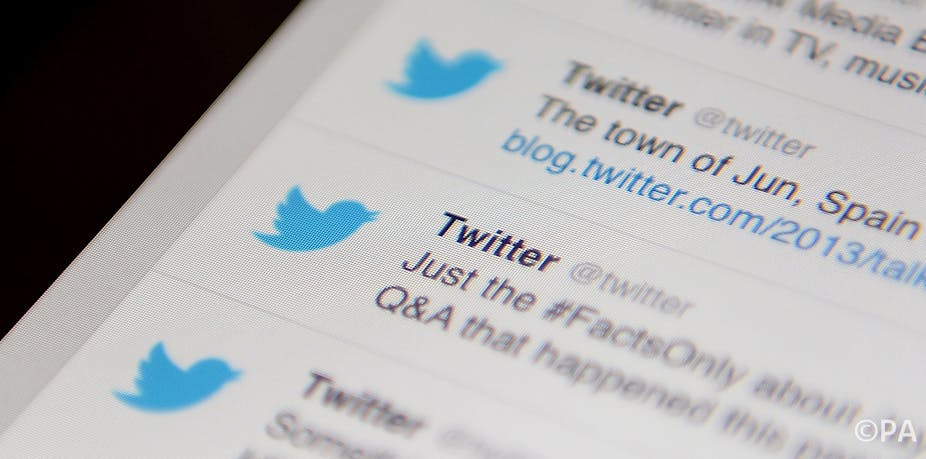Twitter’s Initial Public Offering (IPO) is due to take place on Wednesday. The company values itself at US$12 billion and expects to raise up to US$1.3 billion in sales.
But let’s forget about the money and think about Twitter’s impact in its relatively short lifetime of seven years. On average there are now 500m tweets a day. You don’t even have to tweet to be on Twitter. Some 40% of users simply use Twitter as a “curated news feed of updates that reflect their passions”.
“News feed” is important because Twitter has clearly changed the way news is gathered, disseminated and consumed.
This year’s biggest story, the Edward Snowden/NSA leaks, provides an instructive example. A senior Guardian executive pointed out that, “the story really broke from us and on Twitter. It took an hour before the breaking news stations got this.”
Twitter drives traffic to The Guardian’s sites from areas where there is no print edition. According to Nicky Wolf in The Atlantic, June 10, the day after Snowden revealed his identity on The Guardian‘s website, was the biggest traffic day in the paper’s history, bringing the site 6.97 million unique browsers. “On June 10, for the first time in the paper’s history, their US traffic was higher than their UK traffic.”
In this sense, Twitter facilitates the global expansion of The Guardian into previously difficult-to-reach markets. This is key to the business models of most modern news outlets – reaching new markets is of course a major demand of advertisers.
Newsrooms go social
Social media has transformed newsrooms, speeding up newsgathering and enabling recourse to wider ranges of sources and material.
The corollary of the ubiquity of Twitter is that journalist’s roles have changed significantly. Twitter never sleeps and neither does the modern journalist, who is scanning updates 24/7, posting and retweeting.
This is often a hostile environment. As journalist and blogger Amy Cassell said:
One small error can compound itself instantaneously, thanks to the eager efforts of would-be investigators lurking in the comments section and armed with instant search. Corrections are no longer an afterthought process – they happen in real time for the world to see. This also means that the audience will penalise wrong reporting harshly. So you had better make sure your reporting is ironclad.
Where once correspondents were reachable only through the letters pages, the illusion of journalistic omniscience has been challenged.
News can be broken on Twitter by the participants in, or observers of, a particular event. The journalist often becomes an interpreter, reacting to events quickly and frequently – and he or she often has to sift through swathes of information and opinion before deciding on what to report.
As technology journalist Alex Masters argues, Twitter interaction has become synonymous with news reporting. Media outlets rely heavily on crowdsourced content to “help provide real-time information, reaction and public opinion during breaking news stories”. Consider that this process is relentless and we may begin to sympathise with the modern reporter.
Twitter becomes the news?
There are those who suggest that Twitter has had a trivialising effect on journalism. That it is lazy and convenient for journalists to rely on Twitter “outrages” for news.
A quick look the newspapers in the last few weeks gives some credence to that view. A the Twitter “spat” between Lord Sugar and Nick Clegg made it into The Guardian’s politics section, for instance, and during the recent vicious British weather various newspapers printed the tweets of celebrities who had ridiculed the effects of the storm.
These are just two examples of very many instances and as US media analyst Jeff Sonderman points out:
It is possible to overuse Twitter to the detriment of your other reporting; it is possible to pursue trivial tweetable “scoops” to the detriment of insightful journalism.
But, he says, “the solution isn’t to not use Twitter — it’s to not use Twitter that way”. Perhaps this is the key. It’s the way in which Twitter is used that determines its worth – and the power of the medium should not be underestimated.
Productive usage
There are numerous examples of this sort of productive use of social media. Perhaps most famously, Twitter was successfully used in the Arab Spring of 2011 to mobilise support for change both locally and internationally.
Closer to home, it could be argued that in the early days of the phone hacking scandal it was the campaign on Twitter urging advertisers to refrain from dealing with the News of the World that quickened the paper’s demise.
Genuinely perturbed by the situation and the potential damage by association, one by one major companies began to distance themselves from the newspaper. Just a day after The Guardian broke the story, General Motors, Mitsubishi Motors, the Co-Operative and Lloyds Bank were among those who suspended advertising.
In May the Everyday Sexism Project, “Women, Action and the Media”, launched an international campaign against Facebook content that they felt incited rape and domestic violence. After more than 60,000 tweets using the #FBrape hashtag and another co-ordinated campaign aimed at advertisers, Facebook was forced to issue a statement promising to act upon each of the stipulations called for by Everyday Sexism.
While these are examples of activism and not journalism, they are certainly sources of information. Any news organisation which ignored or completely discounted what was appearing on social media during the Arab Spring would have missed the primary providers of news, both written and visual. That situation is unthinkable.
Twitter’s importance to the future of journalism is evident. Paul Lewis, The Guardian’s Washington correspondent and winner of the best Twitter feed in the Online Media awards said in 2012:
Twitter is the digital footprint of things that are happening around the world. If Twitter becomes as ubiquitous as the mobile phone – there’s 4bn mobile phone users in the world – that’s huge. As a journalist who wants to find out things people don’t want you to know, that’s very exciting.

